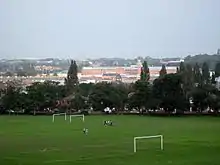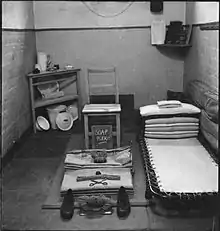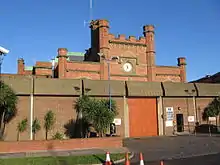HM Prison Wakefield
Her Majesty's Prison Wakefield is a Category A men's prison, located in Wakefield, West Yorkshire, England. The prison is operated by Her Majesty's Prison Service. The prison has been nicknamed the "Monster Mansion" due to the large number of high-profile, high-risk sex offenders and murderers held there.[2][3]
 HM Prison Wakefield in Wakefield. | |

| |
| Location | Wakefield, West Yorkshire, England |
|---|---|
| Security class | Adult Male/Category A |
| Population | 751 (as of November 2007) |
| Opened | 1594 |
| Managed by | HM Prison Services |
| Governor | Tom Wheatley [1] |
History


Wakefield Prison was originally built as a house of correction in 1594. Most of the current prison buildings date from Victorian times. The current prison was designated a Dispersal prison in 1966 and is the oldest of the Dispersal prisons still operating across England and Wales.
The English Dialect Dictionary noted references to Wakefield were often short for referring to the long-standing prison (e.g. "being sent to Wakefield" meant being sent to prison).[4]
"Here We Go 'Round the Mulberry Bush"
The exercise yard at Wakefield had a mulberry tree, around which female inmates used to exercise. This has been linked to the nursery rhyme "Here We Go Round the Mulberry Bush" by the erstwhile prison governor, RS Duncan in his book 'Here we go round the mulberry bush': The House of Correction 1595 / HM Prison Wakefield 1995 (published by author 1994).[5] This origin of the song is also propounded on the prison's website. There is no corroborative evidence to support this theory. The tree was removed in May 2019 as it had died. A cutting from it was taken by a retired prison officer. This will be used in an attempt to grow the tree again.
First World War
During the First World War, Wakefield Prison was used as a Home Office work camp. The ordinary criminal prisoners were removed, and the new influx were sentenced to two or more years' imprisonment for refusing to obey military orders.[6] After the closure of Dyce Work Camp in October 1916, Wakefield Prison was also used to intern conscientious objectors.[7] In September 1918 a group of conscientious objectors took advantage of a slackening in the prison regime that occurred towards the end of the war, by rebelling and refusing to undertake any work.[7] They issued a list of demands for better treatment, known as the Wakefield Manifesto.[7]
IRA prisoners
As a high-security prison, Wakefield was used to house IRA prisoners at various points in the 20th century. In some cases in the 1950s, the IRA attempted to free the prisoners, such as Cathal Goulding in 1956 (the attempt was aborted when the sirens sounded)[8] and James Andrew Mary Murphy in 1959 (who was freed).[9] During a hunger strike by Provisional IRA prisoners, Frank Stagg died in Wakefield Prison on 12 February 1976.[10] The case brought international media attention as the Irish Government denied Stagg's last request for a military funeral march from Dublin to Ballina, and instead arranged for the Irish police to bury him secretly.[11] On 1 March 1976, Merlyn Rees, the Secretary of State for Northern Ireland in the Wilson ministry, announced that those people convicted of causing terrorist offences would no longer be entitled to Special Category Status, which was challenged during later hunger strikes.[12]
Recent history
In 2001 it was announced that a new Supermax security unit was to be built at Wakefield Prison. The unit was to house the most dangerous inmates within the British prisons system, and was the first such unit of its kind to be built in the United Kingdom.[13]
In March 2004 an inspection report from Her Majesty's Chief Inspector of Prisons criticised staff at Wakefield Prison for being disrespectful to inmates. The report claimed that the prison was "over-controlled", and a third of the prison's inmates claimed to have been victimised.[14]
Facilities
Wakefield Prison holds approximately 600 of Britain's most dangerous people (mainly sex offenders and prisoners serving life sentences for violent crimes against women and children). Accommodation at the prison comprises single-occupancy cells with integral sanitation. All residential units have kitchens available for offenders to prepare their own meals. An Incentives and Earned Privileges system allows standard and enhanced offenders the opportunity of in-cell TV. All offenders are subject to mandatory drugs testing and there are voluntary testing arrangements, which are compulsory for all offenders employed, for example as wing cleaners or kitchen workers.
HMP Wakefield offers a range of activities for inmates, including charity work, an accredited course in industrial cleaning, and a Braille shop where offenders convert books to Braille. The Education Department is operated by The Manchester College, and offers learning opportunities ranging from basic skills to Open University courses. Other facilities include a prison shop, gym, and multi-faith chaplaincy.
A prison inspection in 2018 found that Wakefield Prison was on the whole calm, secure, decent and well managed. The rest of the prison service could learn good practise from Wakefield. Despite the above, prisoners needing psychiatric care face unacceptable delays before they are transferred to secure psychiatric hospitals, and prisoners' mental condition worsens while they are waiting for transfer. Peter Clarke said, "Because of the totally unacceptable delays in doing so, many prisoners across the prison estate are held in conditions that are not in any way therapeutic and indeed in many cases clearly exacerbate their condition. (...) The situation at Wakefield was yet another example of prisoners with severe illness not receiving the care that they needed." Inspectors noted a prisoner who was "exceptionally challenging to manage and had complex needs that could not be met in the prison. While staff attempted to manage him positively and constructively, his condition was deteriorating during a lengthy wait to be admitted to a secure hospital," according to the inspection report.[15]
Notable inmates
Current
- Kamel Bourgass – Islamic terrorist convicted of the murder of police officer Stephen Oake and the attempted murder of two other police officers.[16]
- Ian Watkins – Former lead singer and lyricist of the band the Lostprophets, convicted of several sex offences, some involving children and infants. After a period at Wakefield transferred to Long Lartin to enable his terminally ill mother to have easier visitation rights,[17] and subsequently transferred to HM Prison Rye Hill. In August 2019 he was convicted of possession of a banned item, a mobile phone, while back at Wakefield in March 2018.[18][19]
- Mark Bridger, child molester and murderer who abducted and murdered 5-year-old April Jones.[20]
- Robert Maudsley – serial killer and cannibal.[21]
- Jack Renshaw – Neo-Nazi and child sex offender who plotted to murder Labour MP Rosie Cooper.[22]
Former
.jpg.webp)
- Fred Haslam (1897-1979) – a First World War conscientious objector [23]
- Klaus Fuchs – Spy convicted of supplying information from British and American nuclear weapon research to the USSR, served nine years and four months of his fourteen-year term at Wakefield, between 1951 and 1959.
- Ian Huntley – who was convicted of the Soham double child murder, from 2004 to 2008, when he was moved to HMP Frankland.[24]
- Radislav Krstić - Bosnian Serb war criminal[25]
- Dr. Harold Shipman – Widely considered the most prolific serial killer in modern history; committed suicide at Wakefield Prison in January 2004. Shipman had been on round-the-clock suicide watch at two previous prisons, but such 'special measures' had not been deemed necessary after his transfer to Wakefield.[26]
- Michael Sams[27]
- Colin Ireland – Serial killer dubbed "The Gay Slayer" who murdered five homosexual men in a three-month span in the early 1990s; died from Pulmonary fibrosis in 2012.[28]
- Robert Black – Convicted in 1994 of murdering three young girls during the 1980s, spent many years at HMP Wakefield before he was transferred to HMP Maghaberry in Northern Ireland, where he died in 2016.[29]
References
- "Wakefield Prison information". Justice.gov.uk. Retrieved 23 May 2019.
- Thompson, Tony (27 April 2003). "The caged misery of Britain's real 'Hannibal the Cannibal'". The Observer. London. Retrieved 13 July 2011.
- "A long way to go at 'monster mansion'". Wakefield Express. Wakefield. 6 October 2005. Retrieved 14 July 2011.
- English Dialect Dictionary part 6 (1905), Joseph Wright, page 364
- "Rare mulberry trees around our district could be linked to James I". Wakefield Express. 9 September 2016. Retrieved 24 April 2017.
- Webb, Simon (31 January 2016). British Concentration Camps: A Brief History from 1900–1975. Oxford, UK: Casemate Publishers. pp. 58–60. ISBN 9781473846326.
- Kramar, Ann (30 November 2014). Conscientious Objectors of the First World War: A Determined Resistance. Barnsley, UK: Pen and Sword. ISBN 9781473842441.
- The IRA 12th impression, Tim Pat Coogan, pages 346–347, William Collins, Sons & Co., Glasgow, 1987
- The IRA 12th impression, Tim Pat Coogan, pages 410–411, William Collins, Sons & Co., Glasgow, 1987
- The IRA 12th impression, Tim Pat Coogan, page 518, William Collins, Sons & Co., Glasgow, 1987
- The IRA 12th impression, Tim Pat Coogan, page 520, William Collins, Sons & Co., Glasgow, 1987
- http://cain.ulst.ac.uk/events/hstrike/chronology.htm The Hunger Strike of 1981 – A Chronology of Main Events, Dr. Martin Melaugh, University of Ulster: Conflict Archive on the Internet
- "New unit for killer inmates". bbc.co.uk. 23 January 2001. Retrieved 1 February 2009.
- "Staff 'disrespectful' to inmates". bbc.co.uk. 25 March 2004. Retrieved 1 February 2009.
- Inspectors warn of worsening conditions for mentally ill inmates The Guardian. 1 November 2018
- "Muslim extremists plot escape from prison". The Telegraph. Retrieved 14 September 2020.
- "Ian Watkins moved to same prison as child killer Ian Huntley". Wales Online. 24 January 2014. Retrieved 24 January 2014.
- "Paedophile singer 'had phone in prison'". BBC News. 12 March 2019. Retrieved 13 March 2019.
- "Lostprophets' Ian Watkins found guilty of possessing mobile phone he hid up his bum in prison". Birmingmam Mail. 9 August 2019. Retrieved 10 August 2019.
- "Mark Bridger attacked in prison". The Guardian. 9 July 2013. Retrieved 5 September 2019.
- Thompson, Tony (27 April 2003). "The caged misery of Britain's real 'Hannibal the Cannibal'". The Guardian. Retrieved 30 January 2016.
- "Lancashire Man Sentenced To Life". Counter Terrorism Policing. 17 May 2019. Retrieved 5 February 2021.
- Josephson, Harold (1985). Biographical Dictionary of Modern Peace Leaders. Connecticut: Greenwood. pp. 386-7. ISBN 0-313-22565-6.
- "Soham killer treated for overdose". BBC News. 5 September 2006. Retrieved 1 February 2009.
- "Radislav Krstic: Serbian war criminal attacked in British jail". The Daily Telegraph. 8 May 2010.
- "Shipman suicide 'not preventable'". BBC News. 25 August 2005. Retrieved 1 February 2009.
- "Sams receives further 8 years for cell attack". The Daily Telegraph. 16 March 2005. Archived from the original on 16 March 2005. Retrieved 13 March 2019.
- "Torture murderer dies in prison". BBC News. 21 February 2012. Retrieved 22 February 2012.
- "Child killer Robert Black dies in prison". The Herald. Scotland. 12 January 2016. Retrieved 13 January 2016.
External links
| Wikimedia Commons has media related to HM Prison Wakefield. |

